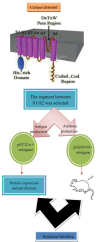Investigation in vitro Expression of CatSper Sub Fragment followed by Production of Polyclonal Antibody: Potential Candidate for The Next Generation of Non Hormonal Contraceptive
- PMID: 23508510
- PMCID: PMC3584432
Investigation in vitro Expression of CatSper Sub Fragment followed by Production of Polyclonal Antibody: Potential Candidate for The Next Generation of Non Hormonal Contraceptive
Abstract
Objective: CatSper is a voltage-sensitive calcium channel that is specifically expressed in the testis and it has a significant role in sperm performance. CatSper (1-4) ion channel subunit genes, causes sperm cell hyperactivation and male fertility. In this study, we have explored targeting of the extracellular loop as an approach for the generation of antibodies with the potential ability to block the ion channel and applicable method to the next generation of non-hormonal contraceptive.
Materials and methods: In this experimental study, a small extracellular fragment of CatSper1 channel was cloned in pET-32a and pEGFP-N1 plasmids. Then, subsequent methods were performed to evaluate production of antibody: 1) pEGFP-N1/CatSper was used as a DNA vaccine to immunize Balb/c mice, 2) The purified protein of pET-32a/CatSper was used as an antigen in an enzyme-linked immunosorbent assay (ELISA) and western- blot, and 3) The serum of Balb/-c mice was used as an antibody in ELISA and western-blot. The statistical analysis was performed using the Mann Whitney test.
Results: The results showed that vaccination of the experimental group with DNA vaccine caused to produce antibody with (p<0.05) unlike the control group. This antibody extracted from Balb/c serum could recognize the antigen, and it may be used potentially as a male contraception to prevent sperm motility.
Conclusion: CatSpers are the promising targets to develop male contraceptive because they are designed highly specific for sperm; although, no antagonists of these channels have been reported in the literature to date. As results showed, this antibody can be used in male for blocking CatSper channel and it has the potential ability to use as a contraceptive.
Keywords: Antibody; CatSper; Contraception; Male Fertility; Sperm Cation.
Figures







Similar articles
-
CatSper channel, sperm function and male fertility.Reprod Biomed Online. 2015 Jan;30(1):28-38. doi: 10.1016/j.rbmo.2014.09.014. Epub 2014 Oct 8. Reprod Biomed Online. 2015. PMID: 25457194 Review.
-
The CatSper calcium channel in human sperm: relation with motility and involvement in progesterone-induced acrosome reaction.Hum Reprod. 2014 Mar;29(3):418-28. doi: 10.1093/humrep/det454. Epub 2014 Jan 15. Hum Reprod. 2014. PMID: 24430778
-
Roles of CatSper channels in the pathogenesis of asthenozoospermia and the therapeutic effects of acupuncture-like treatment on asthenozoospermia.Theranostics. 2021 Jan 1;11(6):2822-2844. doi: 10.7150/thno.51869. eCollection 2021. Theranostics. 2021. PMID: 33456575 Free PMC article.
-
Influence of antifertility agents Dutasteride and Nifedipine on CatSper gene level in epididymis during sperm maturation in BALB/c mice.Reproduction. 2018 Apr;155(4):347-359. doi: 10.1530/REP-17-0664. Epub 2018 Feb 6. Reproduction. 2018. PMID: 29434054
-
Genetic male infertility and mutation of CATSPER ion channels.Eur J Hum Genet. 2010 Nov;18(11):1178-84. doi: 10.1038/ejhg.2010.108. Epub 2010 Jul 21. Eur J Hum Genet. 2010. PMID: 20648059 Free PMC article. Review.
References
-
- Dan JC. Studies on the acrosome. III. Effect of Ca2+ deficiency. Biol Bull. 1954;107(954):335–349.
-
- Bredderman PJ, Foote RH, Hansel W. The effect of calcium ions on cell volume and motility of bovine spermatozoa. Proc Soc Exp Biol Med. 1971;137(4):1440–1443. - PubMed
-
- Yanagimachi R, Usui N. Calcium dependence of the acrosome reaction and activation of guinea pig spermatozoa. Exp Cell Res. 1974;89(1):161–174. - PubMed
-
- Young LG, Nelson L. Calcium ions and control of the motility of sea urchin permatozoa. J Reprod Fertil. 1974;41(2):371–378. - PubMed
-
- Darszon A, Labarca P, Nishigaki T, Espinosa F. Ion channels in sperm physiology. Physiol Rev. 1999;79(2):481–510. - PubMed
LinkOut - more resources
Full Text Sources
Other Literature Sources
Research Materials
